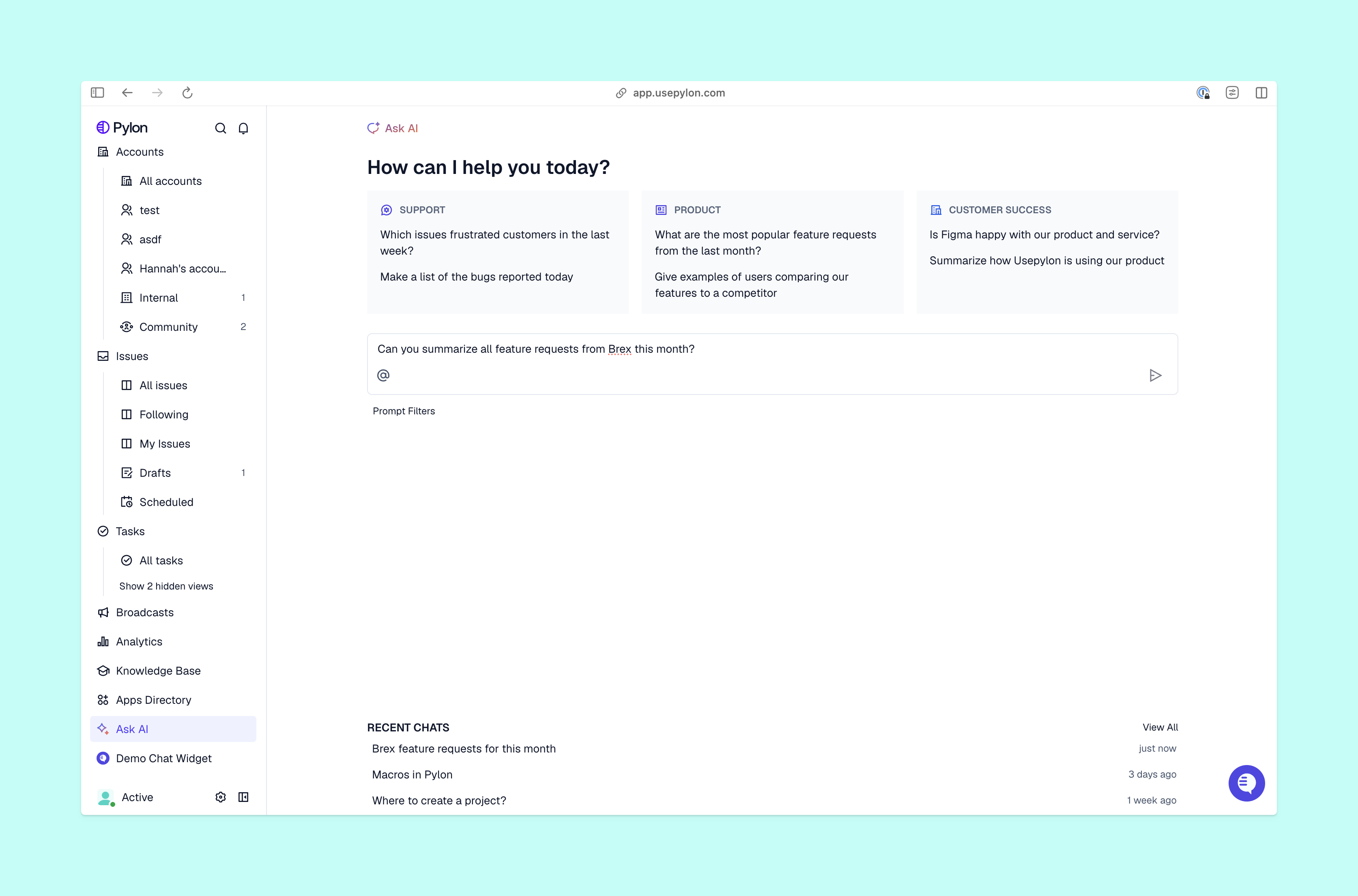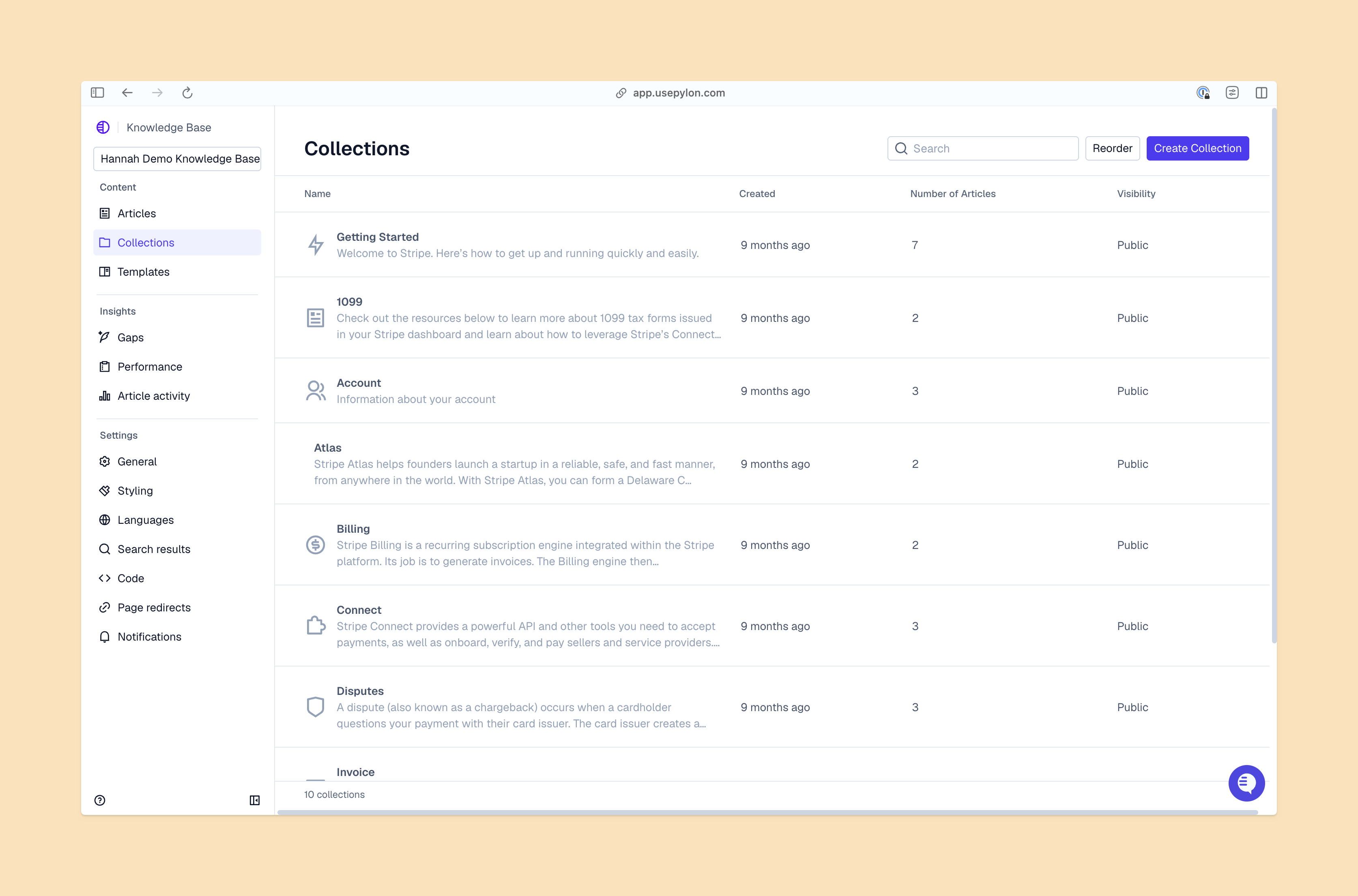AI Ticket Deflection: How to Reduce Your Team’s Support Volume by 60%
Support volumes keep ticking up, but you don't have the budget to proportionally scale your team. Learn how AI ticket deflection can help your team cut support requests by up to 60%.
Updated November 21, 2025 | 15 min read
TL;DR
AI ticket deflection can help B2B companies reduce support volume by 20-60% with intelligent self-service, automated workflows, and knowledge base optimization.
According to Gartner, teams that use AI-first support platforms see 60% higher ticket deflection rates and 40% faster response times compared to traditional help desks. This comprehensive guide covers proven strategies, implementation steps, and real metrics to help you scale support when you can’t proportionally scale headcount.
What Is AI Ticket Deflection?
Ticket deflection is a support strategy where customer questions get resolved or answered before they become formal support tickets. It proactively gives customers answers through self-service channels like AI chatbots, knowledge bases, and automated workflows.
Traditional ticket deflection relied on static FAQ pages and basic help centers. Today's AI-powered deflection uses natural language processing and machine learning to understand customer intent, deliver personalized solutions, and continuously improve based on interaction patterns.

How It Works
When a customer reaches out with a question, AI systems analyze the query to identify intent and context. The system then either:
- Resolves automatically by surfacing relevant knowledge base articles, executing automated workflows (like password resets), or providing conversational AI responses
- Triages intelligently by routing complex issues to the right team with full context
For B2B companies, this means technical questions get answered by your documentation, account-specific queries pull live data from integrated systems, and your team only needs to focus on truly complex issues.
Key Differences: Traditional Deflection vs. AI Deflection
Traditional automated systems follow rule-based workflows that struggle with variations in natural language. AI deflection understands context, learns from patterns, and adapts to new scenarios without manual programming.
Traditional deflection:
- Keyword-based routing
- Static knowledge base search
- Limited to pre-programmed scenarios
- Requires constant manual updates
AI-Powered deflection:
- Natural language understanding
- Contextual, conversational responses
- Learns from historical interactions
- Improves autonomously over time
The Business Benefits of AI Ticket Deflection
A reduced ticket count isn’t the only benefit of AI ticket deflection. Here's how it helps your company scale.
Measurable Cost Reduction
Companies implementing sophisticated AI deflection report cost reductions of 30-55% through reduced staffing needs, improved response times, and higher customer satisfaction scores.
Dramatically Faster Response Times
In documented case studies, companies achieved response time reductions from 15 minutes to 23 seconds—a 97% improvement. This level of responsiveness transforms customer perception and competitive positioning.
Higher Customer Satisfaction
The average ticket deflection rate in the technology industry is 23%, but companies that use AI can get rates of 40-60%. Some best-in-class implementations deflect up to 85% of routine questions.
Improved Team Productivity and Morale
Support teams spend disproportionate time on simple and repetitive requests. AI deflection eliminates this burden by freeing up your team for complex, high-value customer interactions that need human judgment and expertise.
This means higher job satisfaction, reduced burnout, and more strategic impact from your support organization.
5 Proven Strategies to Maximize AI Ticket Deflection
Implementing effective ticket deflection means more than just deploying a chatbot or an AI agent. Here are five strategies that drive measurable results:
1. Build and Optimize Your Knowledge Base
You can deflect well without a comprehensive, well-structured knowledge base. Your documentation is the data source for AI agents, chatbots, and self-service portals.
Action steps:
- Audit your top 20-30 most common support questions and create dedicated articles for each
- Use natural language that matches how customers describe problems, not internal jargon
- Include screenshots, step-by-step instructions, and video walkthroughs where helpful
- Organize content by user journey stages (onboarding, troubleshooting, advanced features)
- Update articles regularly based on ticket trends and customer feedback
For more guidance on building effective knowledge bases, see our guide on best practices for creating a B2B knowledge base.

2. Deploy AI Agents with Contextual Understanding
Modern AI agents can do a lot more than simple chatbot scripts. They understand natural language, access multiple data sources, and execute complex workflows autonomously.
Implementation best practices:
- Train AI agents on actual customer conversations, not just documentation
- Integrate with your CRM, billing system, and product database for personalized responses
- Let agents execute straightforward actions (password resets, account updates, order tracking) without your team’s involvement
- Create escalation paths that preserve conversation context when your team’s help is needed
- Continuously feed new ticket data back into the training process
Learn how AI-powered customer support reduces response times by 97% through proper implementation.
3. Implement Proactive Deflection Throughout the Customer Journey
Don't wait for customers to reach out. Surface helpful content at critical moments throughout their product experience.
Proactive deflection tactics:
- Pre-submission suggestions: When customers start creating a ticket, show relevant articles that might resolve their issue
- Status updates: Automatically notify customers about issues, deployments, or maintenance before they ask
4. Create Intelligent Automation Workflows for Common Requests
Some support requests follow predictable patterns. Automate these entirely with workflow triggers and integrations.
Common automation opportunities:
- Account provisioning and password resets
- Billing inquiries and invoice delivery
- Order status and shipping updates
- Feature availability and product roadmap questions
- Integration troubleshooting with standardized steps
For teams using modern communication platforms, explore how to implement Slack as a ticketing system with integrated automation.
5. Unify Support Across All Customer Channels
Customers don't think in terms of "email support" vs. "chat support." They want consistent help regardless of how they reach out.
Modern omnichannel support platforms like Pylon integrate Slack Connect, Microsoft Teams, email, and in-app chat into a single support system. This enables:
- Consistent AI deflection across all channels
- Unified conversation history that preserves context across touchpoints
- Centralized knowledge management that powers all self-service options
- Consolidated analytics to understand patterns across channels
Learn more about Discord for customer support and Microsoft Teams helpdesk implementation.
How to Measure AI Ticket Deflection Success
There are a few metrics you can track to optimize your approach to AI ticket deflection.
Ticket Deflection Rate
This primary metric shows you what percentage of customer inquiries are resolved without creating a support ticket.
Calculation: Ticket Deflection Rate = (Self-Service Resolutions ÷ Total Support Interactions) × 100
For example, if 400 customers resolve issues through self-service while 100 submit tickets, your deflection rate is 80%.
Industry benchmarks:
- Average: 23% deflection rate
- Good: 40-50% deflection rate
- Best-in-class: 60-85% deflection rate
AI Resolution Rate
Track what percentage of conversations your AI agent fully resolves without your team’s intervention.
First Response Time (FRT)
Measure how quickly customers receive initial answers, whether it’s from AI or your support team.
AI-powered deflection delivers instant responses 24/7. Best-in-class implementations reduce FRT from minutes to seconds, fundamentally changing customer perception.
Self-Service Engagement Metrics
Beyond deflection rates, monitor how customers interact with your resources:
- Knowledge base article views and search patterns
- Chatbot engagement duration and completion rates
- Article helpfulness ratings (upvotes/downvotes)
- Search queries with no results (revealing content gaps)
These metrics guide continuous improvement and content prioritization.
Cost Per Ticket and Operational Efficiency
Calculate the financial impact of deflection by tracking:
- Average agent time per ticket type
- Total team capacity freed by deflection
- Customer satisfaction scores across support channels
Most organizations achieve ROI within 6 months through reduced staffing costs and improved operational efficiency.
Implementation Roadmap: 4 Steps to AI Ticket Deflection
If you want to successfully implement AI ticket deflection, you need to plan strategically and do a phased roll-out. Here’s a roadmap you can follow:
Step 1: Audit Current Support Operations (Week 1-2)
Begin with a comprehensive assessment of your existing support workflow:
Data collection:
- Analyze 3-6 months of ticket history by category, channel, and resolution time
- Identify the top 20 support request types accounting for 80% of volume
- Calculate baseline metrics: total tickets, average handle time, current deflection rate
- Document existing self-service resources and their utilization
Stakeholder interviews:
- Survey your team about repetitive requests and pain points
- Gather customer feedback on current support experience
- Identify integration requirements with existing tools (CRM, ITSM, communication platforms)
This audit establishes your baseline and identifies the highest-impact automation opportunities.
Step 2: Build Your Content Foundation (Week 3-6)
Quality content is essential for effective AI deflection. Prioritize based on ticket volume and complexity:
Content development priorities:
- Create comprehensive articles for your top 20 support requests
- Write in plain language matching customer terminology, not internal jargon
- Include multiple content formats: text guides, screenshots, video walkthroughs
- Optimize articles for search with clear titles and keyword-rich descriptions
- Test articles with actual customers before publishing
Quality standards:
- Each article resolves one specific problem completely
- Step-by-step instructions with expected outcomes at each stage
- Troubleshooting sections for common errors
- Clear next steps if the article doesn't resolve the issue
You can look into knowledge base software that supports AI content suggestions and knowledge gap detection.
Step 3: Deploy AI Deflection Systems (Week 7-10)
Launch your AI deflection stack with a phased approach:
Phase 1: Knowledge base integration
- Embed help center search prominently on your website and in-product
- Implement pre-submission article suggestions when customers start creating tickets
- Add contextual help links throughout your product interface
Phase 2: AI agent deployment
- Start with a limited set of use cases (5-10 common request types)
- Configure AI agent access to knowledge base, CRM, and critical systems
- Set clear escalation triggers for complex issues requiring human expertise
- Monitor conversations closely and refine responses based on outcomes
Phase 3: Workflow automation
- Automate repetitive, rule-based requests (password resets, account updates)
- Create triggers for proactive messaging (onboarding guidance, feature announcements)
- Integrate with communication platforms customers already use
For teams supporting technical customers, review our guides on Slack integrations for customer support and best B2B customer support platforms.
Step 4: Optimize and Scale (Ongoing)
AI deflection improves over time through continuous measurement and refinement:
Weekly optimization:
- Review AI agent conversations that escalated to your team and identify training opportunities
- Analyze searches returning zero results and create content for these gaps
- Monitor deflection metrics by channel and request type
- Gather qualitative feedback from both customers and your team
Monthly reviews:
- Update knowledge base articles based on ticket trends
- Expand AI agent capabilities to handle additional use cases
- Test new automation workflows for emerging patterns
- Benchmark performance against industry standards
Quarterly strategic planning:
- Assess ROI and cost savings from deflection initiatives
- Identify new integration opportunities with product or systems
- Review competitor self-service experiences for inspiration
- Adjust resource allocation based on performance data
For companies considering platform migrations, our article on B2B companies switching from Zendesk and Zendesk alternatives for modern user experience provides comparative guidance.
Best Tools for AI-Powered Ticket Deflection
Choosing the right tools significantly impacts deflection success. Here's what matters most:
Essential Platform Capabilities
AI agent functionality:
- Natural language processing that understands intent and context
- Machine learning that improves from historical interactions
- Multi-turn conversation handling for complex troubleshooting
- Seamless escalation to support teams with preserved context
Knowledge management:
- AI that detects knowledge gaps
- Version control and content approval workflows
- Analytics that show which articles drive deflection
- Multi-language support for global teams
Automation and integration:
- Workflow builders for common request types
- Native integrations with CRM and communication platforms
- API access for custom integrations
- Pre-built connectors for popular business systems
Analytics and reporting:
- Real-time deflection metrics across channels
- Conversation transcripts with AI performance scoring
- Cost savings calculations and ROI tracking
- Customer satisfaction measurement throughout the journey
Platforms like Pylon are built for AI-native B2B support, so you can answer your customers quickly and accurately.
Choosing the Right Solution
When you’re evaluating platforms, prioritize:
- AI quality and training data: Solutions trained on billions of real support conversations outperform those with limited training
- Integration breadth: Your deflection system should connect to existing tools customers and your team already use
- Implementation speed: Look for platforms promising deployment in weeks, not months
- Scalability: Ensure the platform handles growth without proportional cost increases
- Vendor expertise: Choose providers with deep experience in your industry or use case
For teams currently using traditional systems, review our comprehensive guides on help desk software and ticketing systems and customer service software options.
Frequently Asked Questions (FAQ)
1. What’s a good ticket deflection rate?
Industry benchmarks suggest 23% average deflection for tech companies, but best-in-class organizations achieve 40-60% or higher. The "right" rate depends on your product complexity and customer expectations. Focus on deflecting routine inquiries while ensuring complex issues reach human experts quickly.
2. How long does it take to implement AI ticket deflection?
Implementation timelines vary by platform and organizational complexity. Modern AI-first platforms can deploy in 30 days or less, while legacy system migrations may take 3-6 months. The key is starting with a limited scope and expanding iteratively rather than attempting a full transformation simultaneously.
3. Will AI deflection hurt customer satisfaction?
Research shows the opposite: 86% of customers expect self-service options, and 69% prefer resolving issues independently when possible. Poor deflection implementations hurt satisfaction, but quality AI experiences improve CSAT scores by reducing wait times and providing instant answers. The key is ensuring accuracy and maintaining clear escalation paths.
4. How much does AI ticket deflection cost?
Costs vary significantly by platform and company size. Modern solutions often use conversation-based pricing rather than per-seat licensing, making them more cost-effective for growing teams. Most organizations achieve ROI within 6 months through reduced staffing costs and improved efficiency. Expect initial investments in platform fees, implementation services, and content development.
5. What types of support requests work best for deflection?
Highest-impact deflection opportunities include: password resets and account access, billing inquiries and invoice delivery, order/shipment status checks, product documentation and how-to questions, feature availability and roadmap queries, and integration troubleshooting with standard steps. Complex technical issues, sensitive account problems, and emotionally charged situations typically require your support team to step in.
6. Do I need to replace my existing help desk to implement AI deflection?
Not necessarily. Some AI deflection capabilities can integrate with existing systems through APIs and middleware. However, legacy platforms often lack the architecture to fully leverage modern AI. Many companies find that migration to AI-first platforms delivers better results than retrofitting older systems. Review our guide on switching from Zendesk for migration considerations.
7. How do I measure ROI from ticket deflection initiatives?
Calculate ROI by measuring: tickets deflected multiplied by average cost per ticket, how many hours your team saves and reallocates to high-value work, reduced hiring or outsourcing costs, improved customer satisfaction scores, faster time-to-resolution metrics, and decreased churn from improved support experiences. Most analytics platforms provide built-in ROI calculators tracking these metrics automatically.
8. What's the difference between ticket deflection and ticket resolution?
Ticket deflection prevents ticket creation by resolving inquiries through self-service before formal submission. Ticket resolution measures how many submitted tickets are successfully closed. High deflection rates reduce volume before it reaches your queue; high resolution rates measure your team’s effectiveness on tickets that do get created. Both metrics matter, but deflection has greater operational leverage.
9. How do I prevent AI from providing incorrect answers?
Accuracy requires: comprehensive, regularly updated knowledge bases, AI training on actual customer conversations (not just documentation), human-in-the-loop review for new response types, confidence thresholds that escalate uncertain queries to humans, continuous monitoring of AI conversation quality, and rapid correction of identified errors. Start with limited use cases and expand as accuracy improves.
10. Can AI deflection work for complex B2B technical products?
Of course. Technical products often generate numerous documentation questions, integration troubleshooting requests, and API usage queries—all ideal for AI deflection. The key is maintaining developer-friendly documentation, supporting code examples and technical specifications, integrating with your product to provide contextual help, and ensuring smooth escalation to technical support specialists when needed. Learn more in our B2B customer service guide.
Start Deflecting Tickets Today
AI ticket deflection can help you drastically reduce ticket volume, respond to customers faster, save on operational costs, and free up your team for complex work.
The key is implement it strategically: audit your current operations, build quality content, deploy AI agents incrementally, and continuously improve your set-up with data.
Pylon is the modern B2B support platform that offers true omnichannel support across Slack, Teams, email, chat, ticket forms, and more. Our AI Agents & Assistants automate busywork and reduce response times. Plus, with Account Intelligence that unifies scattered customer signals to calculate health scores and identify churn risk, we're built for customer success at scale.







